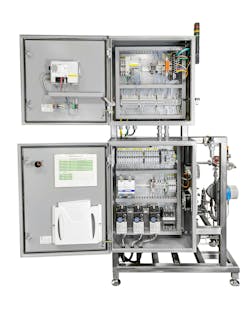Automation and PLC controls for chemical inline blending and homogenizing systems
Inline blending and homogenizing is the process of metering various liquid chemicals such as solvents, cleaning agents, surfactants, emulsifiers, silicones, biocides and other preservatives, and mixing them on their way to storage or buffer tanks. The mixing technologies used in this process may vary and include inline static mixers, inline rotor/stator mixers or an inline high-pressure homogenizer, such as Sonic Corporation’s Sonolator, for example. A Sonolator is like an inline static mixer — but it has no moving parts and mixes inline by subjecting fluid to extreme velocity change over a short distance.
By metering and mixing inline, large and cumbersome batch tanks are eliminated from the process. This saves floor space and reduces cost. This also saves significant time as formulations can be made on-demand without wasting time transferring ingredients into a vessel, only to be transferred again to a hold tank or a buffer tank downstream.
Figure 1 illustrates the general setup of three liquid ingredients held in upstream storage silos or vessels. The gray box with positive displacement (PD) pumps, flowmeters and other instrumentation is the inline mixing and blending skid. Finally you have a fill or buffer tank that feeds a downstream filling process or could be eliminated if you go directly to filling process or large storage vessels. Windshield washer fluid would be a good example where methanol, held in bulk storage and connected to the inline blend skid PD pump, is metered alongside water drawn directly from city water supply. A third pump would be used to meter a dye/glycol solution. These ingredients flow in one end of the skid, and the skid PID control maintains ingredients at proper ratio and blends them inline while simultaneously transferring the final solution downstream.
Inline blending and homogenizing skids feature onboard automation and control solutions installed in Nema-rated cabinets, XP enclosures or purged cabinets to meet various hazardous area ratings.
High level PLC automation hardware and software, offered by the likes of Allen Bradley, Siemens, Mitsubishi and more, allow for extremely accurate ratio control between liquid ingredients. A typical PLC control scheme involves PID control blocks that take incoming signals, via ethernet or 4-20 mA wiring, from high-end mass flowmeters and generates an outgoing signal to a variable frequency inverter drive. A control scheme that controls each pump independent of the other allows for faster ramp-up and longer-term stability. A control scheme where ingredient flows are controlled in ratio to one another means you are always chasing a moving target and the loops take longer to settle down, putting more product out of ratio at any given time.
In the chemical processing industry, finding a company that has various skill sets, such as panel fabrication and design and PLC/HMI programming, all in house under one roof, is key. Companies that farm out this work tend to understand less of the important intricacies of providing the necessary infrastructure and process control to make for a successful system.
Blending and homogenizing skid manufacturers should have many years of experience in and out of process plants. Such knowledge allows for system programming of upstream and downstream processes such as tank level or temperature control, feed pump pressure control automation, valve switching, quality control instrumentation control and more.
Perhaps most importantly for chemical processing companies, a qualified skid designer will need the ability to offer systems that meet hazardous area ratings, whether they be North American-based class- and division-rated or European and Asian Atex- and Zone-rated. Addressing safety issues and committing to proper risk assessment requires understanding of various wiring practices, whether they be C1D2 cabling, C1D1 conduit network designs, intrinsically safe circuit design and implementation and much more.
Once a process skid introduces a flammable fluid into the manufacturing environment, you need to consider risks such as ignition source, possible spill or leakage points, and design the skid at a minimum in accordance with Class 1 – Div 2 where a flammable vapor could be present at any time but not continuously. Knowing these differences impacts fabrication costs and reduces capital expense for your customers.
In the final analysis, it is all about the customer and providing a cost-saving and time-saving mixing and blending solution that meets stringent safety requirements both mechanically and electrically.
Rob Brakeman is the owner/director of Sonic Corp. His company specializes in the custom design and fabrication of high-pressure homogenizer systems and inline blending skids. The company’s flagship homogenizer, the Sonolator, is designed into custom systems that emulsify and disperse a wide range of fluids in all major industries.
Sonic Corporation


